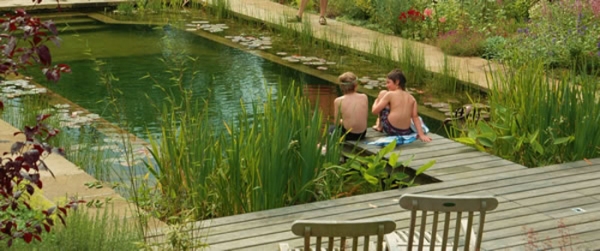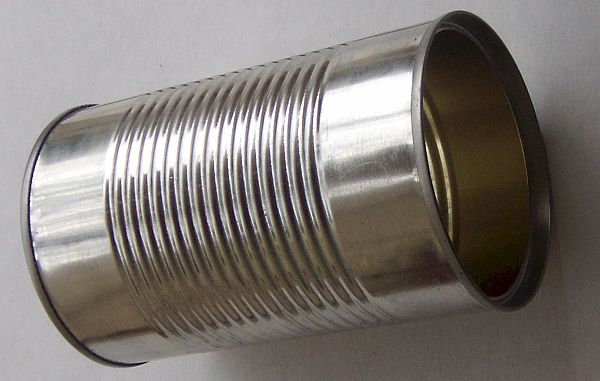
In this age of increasing eco-awareness, natural swimming pools are gaining popularity. Now, what are those details that make natural swimming pools much sought-after? To know this, first we need to know what a natural swimming pool actually is. It is an eco-system consisting of a constructed water body, which is contained in a fairly large area, incorporating natural flora and fauna. In such pools, no chemicals or devices are made use of for disinfection. All the clarifying and cleaning of water is through biological filters and aquatic plants. Such a natural water body will invite the organisms in nature associated with it and a natural ambiance is thus created.
Difficulty Level: Easy
Time Required: Around 6 weeks
Resources Required
1. Good quality sand & gravel
2. Portland Cement
3. Suitable plants
4. Clean water from a known source
5. Pump set
6. Aerator
7. Skimmer
8. Digging tools.
9. Pavement tiles for the pool perimeter.
Estimate Cost: $2000 to $ 6000
Instructions
1. Digging
The primary task is to set aside the area for the pool. Some people opt to have a pool in front side of the building, which some prefer to have it at the backyard. Once selected, digging is to be done. The pond can be deep or shallow as you wish. Whatever be the depth, take care to have sloping sides or otherwise soil would cave in into the pool. The ratio of depth to width usually followed is 1 ft. of vertical depth to every 3 ft. of horizontal stretch.
2. Zoning
Set aside area in the pond for shallow plants. This is for the process of biological filtration. Make sure to separate the swimming area from the plant zone, which can be achieved by a shallow rim within an inch of the water surface. The fibrous roots of the plant removing contaminants and the decompose organisms of the plant root eat away the bacteria.
3. Water Filtration
The water in the pond should be continuously on the move for the plant roots to execute the cleaning job. This can be made possible by an underwater pump which will channel water to the plant roots through a PVS tube.
4. Providing aeration
Aerating the water is very important so as to meet the constant need of Oxygen of the aquatic organisms. This is achieved by an aerator installed in water. An aerator, water pump and skimmer can be installed in the deepest point under water, in a plastic container, taking the help of a skilled electrician. The skimmer removes any outside litter that would sink into water and contribute to growth of algae.
5. The Pool Base
Usually people prefer to have a pool 5 ft. deep, For the bottom either a concrete slab can be poured and set to shape or the bottom can be covered with a rubber liner. Leave the bottom to settle along a period of one week, before filling with water.
6. Filling-up with water
Once you have done with the above procedures,, fill the plant zone with soil and gravel. The soil should be free of decomposed plant and animal material or otherwise it will rot under water. Now you can fill the pool with water, taking care to give only minimum disturbance to the soil.
7. Selection of Plants
Choose plants suiting your climate. A mix of floating, submerged and emergent plants should make a good pond flora. Water lilies, adapt to any depth hence can be used liberally. Arrow head, Pickerel wee, Hornwort, Common waterweed, Rushes, Sedges, Cattails, Irises etc are some of the commonly used plants for the natural swimming pool.
8. Planting
Once selection of plants are made plant them (except the floating ones), in the soil and fix them in place with plenty of gravel.
Frequently asked questions
1. What should be the temperature of a swimming pool?
Ans: The ideal pool temperature is 78 â 820 F
2. Can I have fishes in the pool?
Ans: A small number of fishes can be kept in the swimming area.
3. Can swimming pool water used inside house?
Ans: Yes, it makes a better option to use this natural water.
4. Will the water be clear as in chlorinated pool?
Ans: Clarity changes daily. Good aeration can maintain clear water.
5. Can the existing swimming pool be converted to a natural swimming pool?
And: Yes, this can be done by building a regeneration zone around the pool.
Quick tips
1. Check the mechanical systems regularly
2. Check air hoses for any cracks or obstructions
3. Wipe diffusers with vinegar to remove deposits
4. Bue inexpensive test kits to monitor poolâs nutrient levels.
Things to watch out for
1. Prevent algae growth by planting other plants which will outgrow the algae.
2. If babies and pets are around, fence the pool to avoid any mishaps.
3. Guard your pool from littering from, leaves or human waste.




